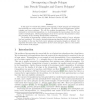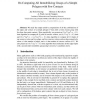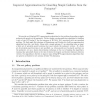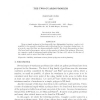COMGEO
2008
ACM
14 years 2 months ago
2008
ACM
In this paper we consider the problem of decomposing a simple polygon into subpolygons that exclusively use vertices of the given polygon. We allow two types of subpolygons: pseud...
ALGORITHMICA
2006
14 years 2 months ago
2006
: We study the output-sensitive computations of all the combinations of the edges and vertices of a simple polygon P that allow a form closure grasp with less than four point conta...
DCG
2010
14 years 2 months ago
2010
Given a simple polygon with rational coordinates having one vertex at the origin and an adjacent vertex on the x-axis, we look at the problem of the location of the vertices for a...
CORR
2010
Springer
14 years 2 months ago
2010
Springer
We provide an O(log log OPT)-approximation algorithm for the problem of guarding a simple polygon with guards on the perimeter. We first design a polynomial-time algorithm for bui...
ALGORITHMICA
2010
14 years 2 months ago
2010
We consider a novel class of art gallery problems inspired by wireless localization. Given a simple polygon P, place and orient guards each of which broadcasts a unique key within ...
CCCG
1997
14 years 4 months ago
1997
In this paper we prove that for any simple polygon P with n vertices, the sum of the number of strictly internal edges and the number of strictly external visibility edges of P is...
CCCG
2010
14 years 4 months ago
2010
The cluster connecting problem inside a simple polygon is introduced in this paper. The problem is shown to be NP-complete. A log n-factor approximation algorithm is proposed.
CCCG
2010
14 years 4 months ago
2010
The straight skeleton of a simple polygon is defined as the trace of the vertices when the initial polygon is shrunken in self-parallel manner [2]. In this paper, we propose a sim...
CCCG
2010
14 years 4 months ago
2010
So far, the best result in running time for solving the fixed watchman route problem (i.e., shortest path for viewing any point in a simple polygon with given start point) is O(n3...
COMPGEOM
1991
ACM
14 years 6 months ago
1991
ACM
Given a simple polygon in the plane with two distinguished vertices, s and g, is it possible for two guards to simultaneously walk along the two boundary chains from s to g in suc...




